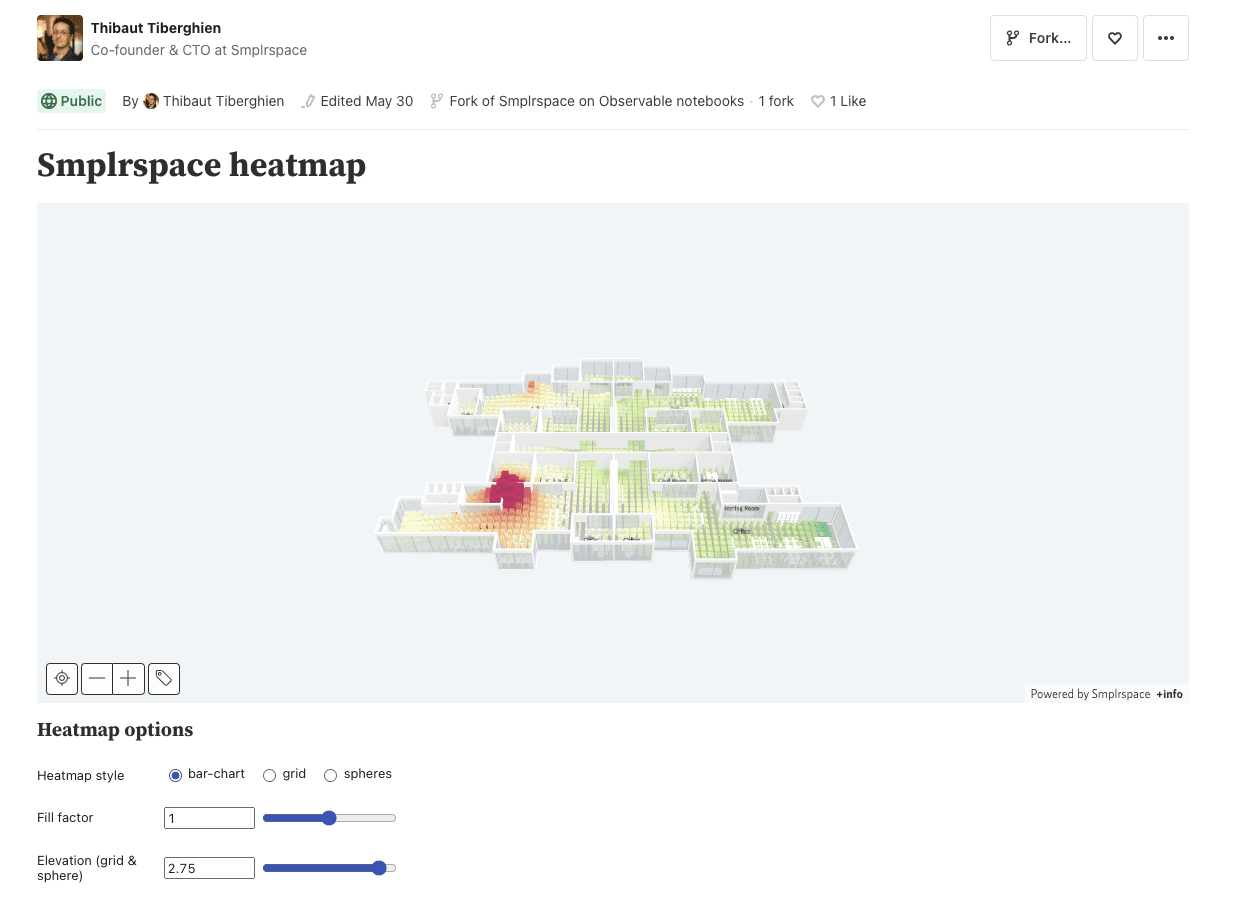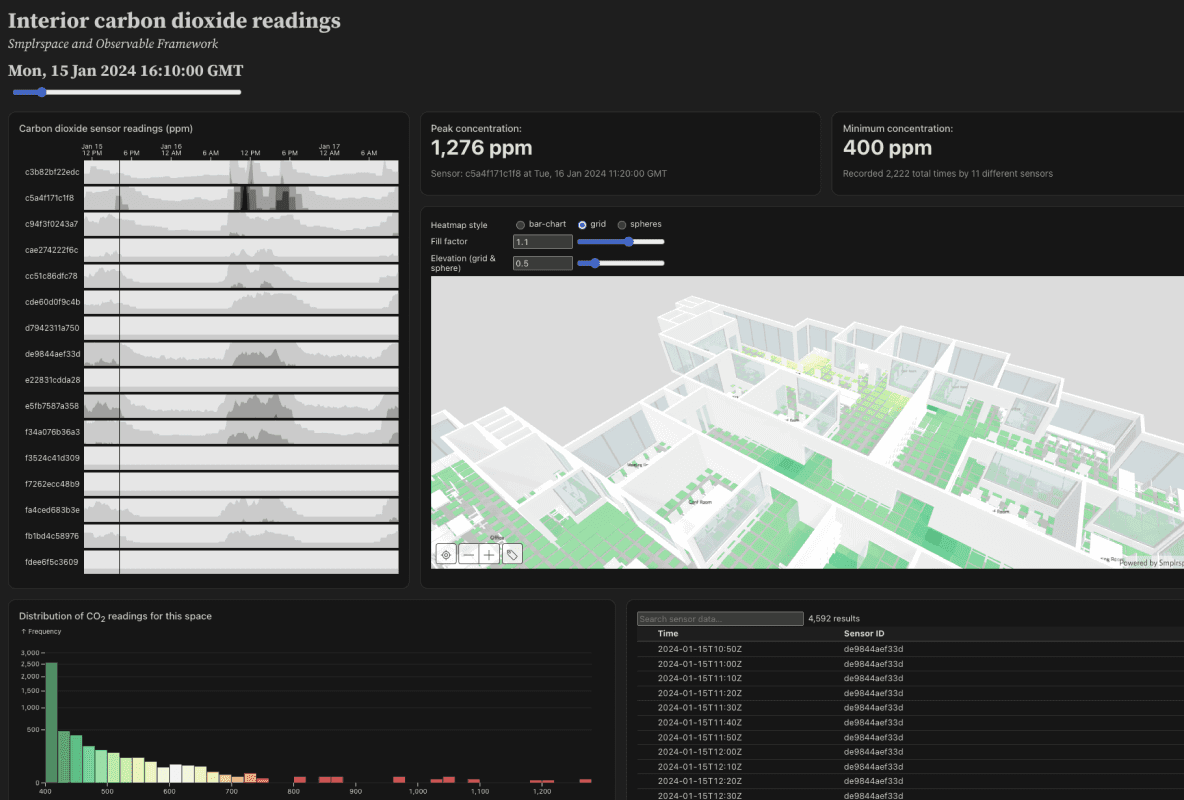In today’s evolving commercial real estate sector, owners and property managers face increasing challenges in optimizing asset performance and operational efficiency. The complexity of managing commercial properties at scale often involves navigating a labyrinth of disparate systems, where access to reliable, consolidated property data is crucial for informed decision-making. Adding to this challenge is the difficulty of contextually understanding these data points without physically being present in the space.
Smplrspace addresses these challenges with its lean digital twin technology that property owners can use to quickly develop accurate, virtual spatial mappings of real-life floor plans and properties. Once the digital twin is created, property owners can add data layers to visualize applications like facility occupancy, IoT device data, leasing reports, air quality, and other assets within a digital space.
Integration with Observable Framework
Smplrspace wanted to enhance the value of their technology by integrating with a partner in the business intelligence space. They were specifically seeking a JavaScript-based solution, recognizing JavaScript’s popularity and extensive use among developers. Integrating with Observable Framework was an ideal choice, given its open-source nature, polyglot language compatibility for data handling, and robust community.
By importing the Smplrspace JavaScript library (smplr.js) into an Observable Framework project, developers can build data apps that seamlessly embed Smplrspace’s spatial floor plans into their apps. Additionally, developers can use Smplrspace data layers within Observable Framework to create custom interactive inputs that control Smplrspace spatial map properties, as well as custom charts and blended metrics.
To demonstrate this integration, Smplrspace and Observable co-developed a showcase data app exploring time series indoor carbon dioxide concentrations.
The spatial map of air quality was initially prototyped in an Observable notebook, which, according to Thibaut Tiberghien, CTO of Smplrspace, “[is] the ideal environment for experimenting with different visualization and analytical approaches, while also enabling easy sharing and collaboration within the team.”
I see Observable as a BI stack, and love how our whole workflow is covered. We start with quick collaborative exploration in notebooks, where you throw data and viz ideas together without caring too much about setup or structure, test out options in parallel and see them react to any analysis. Then in one command-line you convert the notebook into a proper data app running on Framework. From there, it’s quick to clean up, add layout from their built-in options, add some data refresh triggers, and deploy in Observable’s hosted cloud, or anywhere via CI.
Thibaut Tiberghien
With the prototype complete, the drafted visualizations and code were migrated to and finalized in a custom data app made with Observable Framework.
From internal BI to solution prototyping
In addition to building user-facing dashboards with Observable Framework, Smplrspace also uses Observable for their own internal business intelligence. For example, they recently used Observable to forecast impacts of a repricing strategy on revenue and customer costs. Smplrspace also maintains an internal metrics dashboard linked to their data warehouse, providing custom insights into progress towards organizational goals. For that project, they used Observable notebooks as the “go-to environment” for fast, collaborative data wrangling.
Thibaut highlights why they chose Observable over other tools: “Observable supports the entire workflow from discovery to delivery, with easy deployment using any infrastructure and seamless CI integration to control data updates. The platform’s speed is another major advantage, allowing for rapid development and iteration.”
Observable: powering internal BI and user-facing analytics
Observable provides an end-to-end, code-first BI intelligence and analytics solution that accelerates Smplrspace's internal data workflows, and makes it easier for their customers to independently visualize digital twins with property data.
I love how Observable supports us both for internal data operations, and user-facing data apps. We’re excited to see it grow to a point where our clients’ data teams can now bring Smplrspace visualization inside their own Observable environment, keeping the ball rolling.
Thibaut Tiberghien



